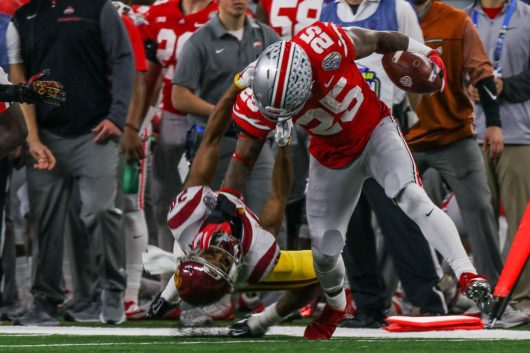
Ohio State sophomore running back Mike Weber (25) takes down a defender while running the ball in the second quarter of the 2017 Cotton Bowl against University of Southern California on Dec. 29 in AT&T Stadium in Arlington, TX. Ohio State won 24-7. Credit: Jack Westerheide | Photo Editor.
After redshirt sophomore running back Mike Weber rushed for 1,096 yards as a redshirt freshman in 2016, he seemed to have locked up a second year as Ohio State’s starter in 2017.
But a confluence of events, including Weber suffering a partially-torn hamstring before the season began and freshman J.K. Dobbins exploding with a 29-carry, 181-yard debut in the opener against Indiana, led to Weber becoming a backup. As each week passed, Weber’s role became clearer: he would be the second option behind Dobbins, even when fully healthy.
Now, after that season as a backup in which he totaled 101 carries for 626 yards and 10 touchdowns, Weber has a decision to make.
The redshirt sophomore must determine whether to return to Ohio State for a fourth year or to end his collegiate career and head to the NFL. The choice is not simple. If he comes back, he would have to battle for carries with Dobbins, a strong group of backups and two incoming four-star backs and more carries would wear on his body. But if he decides to leave, he might not even get drafted considering his lack of chances last season and recent nagging injuries.
On Saturday, he offered a hint that he will be returning for another season at Ohio State, tweeting “One more year.” He then posted a picture on Instagram with the caption, “One more ride.”
The deadline for players to enter the NFL draft early is Jan. 15.
Weber’s indication of a return might mean more to Ohio State’s next quarterback than anyone else. The past four seasons, quarterback J.T. Barrett ran not only the offense’s passing game, but controlled the run game as well. With 3,053 passing yards and 798 rushing yards, Barrett accounted for more than half his team’s yards last season.
But he’s gone now. A quarterback draw by Barrett, the safety blanket that head coach Urban Meyer often relied upon when nothing else worked, will no longer be an option for the Buckeyes. No longer will Barrett be able to act as a battering ram on third downs.
Instead, a new quarterback — either Dwayne Haskins, Tate Martell or Joe Burrow — will take snaps. No matter who wins the quarterback competition, whether it be pocket-passing Dwayne Haskins or dual-threats Tate Martell and Joe Burrow, no one offers the bruising running style of Barrett. That’s one of the areas in which a potential Weber return affects the offense.
Instead of running the quarterback in short-distance situations and near the goal line, Ohio State might move toward more of a running back-powered game. Then, Weber could replace Barrett as the bruiser up the middle near the goal line and in short-yardage situations. He would take pressure off a first-year quarterback.
Weber would become an especially intriguing option if Haskins wins the starting job because though the redshirt freshman has proven an adept scrambler when the pocket breaks down, he does not have a background that implies he would be a consistent option on designed runs.
A returning Weber would have to compete with Dobbins for touches. But in an optimal offense, they might not be competing, but rather be used as complements, unlike during last season when the offense never figured out an optimal rotation of the duo. Finally against USC in the Cotton Bowl, Ohio State ran a few plays with both backs on the field at once.
If healthy, Weber could become the thunder to Dobbins’ lightning. He could be the power back with speed that many people have envisioned him being and that he showed at times during the latter part of the 2017 season. He was not healthy enough to showcase the expected increase in speed that he and running backs coach Tony Alford mentioned before the season.
After Ohio State’s blowout win against Bowling Green on Sept. 3, 2016, Weber compared H-back Curtis Samuel and himself to former USC running backs Reggie Bush and Lendale White.
“We can get there,” Weber said. “We can probably even be better. I think we can be a really good 1-2 punch.”
Both had productive seasons, but that season, Ohio State’s offense had many flaws, and Weber and Samuel were not viewed in a similar light to Bush and White. With a new quarterback and a run game featuring running backs, the possibility arises that two year later, Weber could have his thunder-and-lighting relationship with Dobbins, instead.
Weber might not be the sole starter since Dobbins had 1,403 rushing yards as a freshman, but his return will help mask parts of the offense Ohio State lost with Barrett’s graduation and he could prove to be an optimal partner in the backfield with Dobbins.


